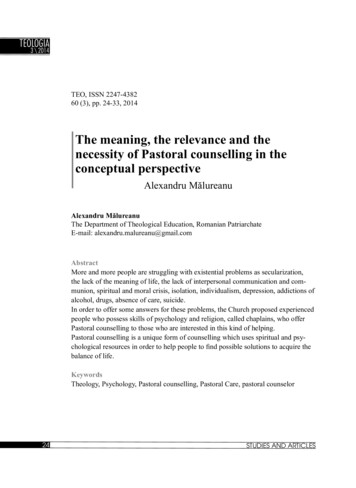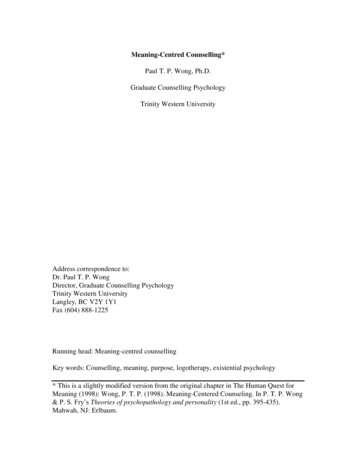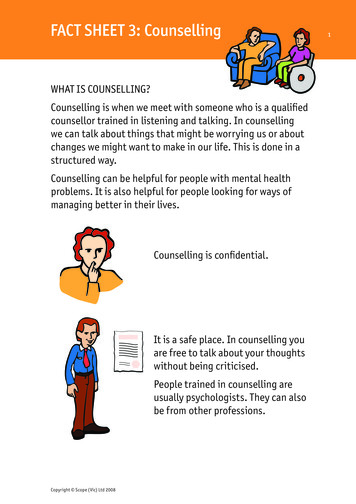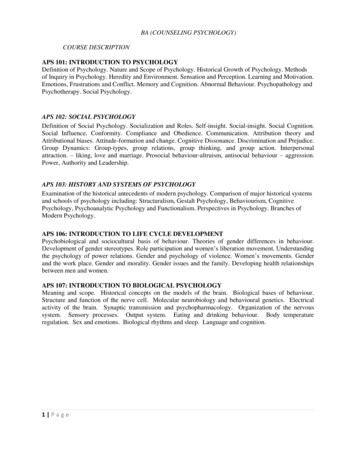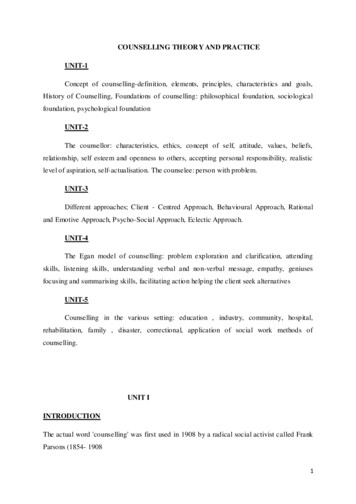
Transcription
REINVENTING YOUR LIFETHE BREAKTHROUGH PROGRAMTO END NEGATIVE BEHAVIOR .AND FEEL GREAT AGAINPLUMEPublished by the Penguin GroupPenguin Putnam Inc., 375 Hudson Street, New York, New York 10014,U.S.A.Penguin Books Ltd, 27 Wrights Lane, London W8 STZ, EnglandPenguin Books Australia Ltd, Ring wood, Victoria, AustraliaPenguin Books Canada Ltd, 10 Alcorn Avenue, Toronto, Ontario, CanadaM4V 3B2Penguin Books (N.Z.) Ltd, 182-190 Wairau Road, Auckland 10, NewZealandPenguin Books Ltd, Registered Offices: Harmondsworth, Middlesex,EnglandPublished by Plume, a member of Penguin Putnam Inc.Previously published in a Dutton edition.First Plume Printing, May, 199430 29 28 27 26 25Copyright Jeffrey E. Young and Janet S. Klosko, 1993 All rights reservedLIBRARY OF CONGRESS CATALOGING-IN-PUBLICATION DATAYoung, Jeffrey E.Reinventing your life: the breakthrough program to end negativebehavior . and feel great again
ISBN 0-452-27204-1Printed in the United States of AmericaWithout limiting the rights under copyright reserved above, no part ofthis publication may be reproduced, stored in or introduced into a retrievalsystem, or transmitted, in any form, or by any means (electronic,mechanical, photocopying, recording, or otherwise), without the priorwritten permission of both the copyright owner and the above publisher ofthis book.BOOKS ARE AVAILABLE AT QUANTITY DISCOUNTS WHENUSED TO PROMOTE PRODUCTS OR SERVICES. FORINFORMATION PLEASE WRITE TO PREMIUM MARKETINGDIVISION, PENGUIN PUTNAM INC., 375 HUDSON STREET, NEWYORK, NEW YORK 10014.
For Manny, Ethel, and Hannes, who have loved and supported meunconditionally.—Jeffrey YoungFor my mother, father, Michael, and Molly, who all gave me the space towrite this book.—Janet Klosko
AcknowledgmentsReinventing Your Life has special meaning. This book represents theculmination of years of personal and professional growth for each of us. Forthis reason, we have many people to thank, past and present, who have insome important way contributed to our development.We are indebted to Dan and Tara Goleman, without whose guidance,faith, advice, gentle prodding, and of course, friendship, we would neverhave undertaken such an overwhelming project; to Arthur Weinberger, forhis suggestions and encouragement during many years of developing theschema-focused model; to William Zangwill, who, in his invaluable role asdevil’s advocate and critic, has inspired us to sharpen and refine our ideas;to David Bricker, who, through his involvement in new approaches topsychotherapy, continually offers us fresh perspectives to consider; to CathyFlanagan, for her help in running the Center, her intelligent comments, andher warmth; to Bill Sanderson, who has played an important role asDirector of Training at the Cognitive Therapy Center of New York and asco-director at the Cognitive Therapy Center of Long Island; to MartySloane, Richard Sackett, Jayne Rygh, and all our other friends andcolleagues in New York who have contributed to the development of thisapproach; and to our editors Deb Brody and Alexia Dorszynksi, who helpedgive the book its form and tone, and to our agent Pam Bernstein, whohelped make the book possible.—JY and JKI would like to extend my personal thanks to several other people whohave played important roles in my development. To Janet Klosko, formaking this collaboration so stimulating and fruitful. I could not have„reinvented“ anyone better to work with; to Will Swift, who, like my father,has always had supreme confidence in me, even when I was not so sure—thank you for helping me get my ideas on tape, and for providing crucialfeedback over the past eight years; to Aaron (Tim) Beck, who, through hisclinical wisdom, penetrating intelligence, and empirical approach topersonal and professional problems, has served as my mentor. To Peter
Kuriloff and Arthur Dole, my graduate school advisors, for their friendship,for having confidence in me, and for being open enough to give me thefreedom to pursue cognitive therapy before it was widely accepted; toCandice, for putting up with me and for her devotion in shouldering muchof the responsibility I cannot handle; to Richard and Diane Wattenmaker,Bob Spitzer, Janet Williams, Gene D’Aquili, and many others who havecontributed in ways they probably do not realize.I have been fortunate throughout my life to have a family that I canalways rely on for praise, reassurance, and acceptance, regardless of what Ihave gone through personally. For accepting all my quirks, I would like tothank my parents, grandparents, brother Stephen, sister Debra, and the othermembers of my extended family. I have learned through working withpatients less fortunate than I not to take such support for granted.—JYI would like to thank all the other people who helped me become thepsychologist that I am. I would like to start by thanking Jeff Young, forbeing such an exemplary model, and for giving me the best form of therapyI have ever known. I would like to thank my mentor, David Barlow, forteaching me the meaning of the word „professional,“ and for encouragingme to fulfill my talents. I would like to thank my supervisor in New YorkCity, Will Swift; Ann De Lancey, Mike Burkhardt, and my fellow internsand other advisors from Brown University; and from SUNY at Albany—Jerry Cemy, Rick Heimberg, John Wapner, Glen Conrad, Robin Tassinari,Jim Mancuso, Robert Boice, Bill Simmons, Alan Cohen, my warmsupportive classmates, and others. Finally, I would like to thank the othermembers of my family and close friends, for everything they have givenme.—JK
FOREWORDBY AARON BECK, M.D.I am delighted that Jeffrey Young and Janet Klosko have tackled thedifficult issue of personality problems, drawing upon the techniques andprinciples of cognitive therapy. The authors have done pioneering work indeveloping and making available to the public a powerful set of tools formaking significant life changes in relationships and at work.Personality disorders are self-destructive, lifelong patterns that bringpatients tremendous unhappiness. People with personality disorders havelong-term problems with living, in addition to specific symptoms likedepression and anxiety. They are often unhappy in their intimaterelationships or chronically underachieve in their careers. Their overallquality of life is usually lower than they desire.Cognitive therapy has been expanding to meet the challenge of treatingthese difficult, chronic patterns. In treating personality problems, weaddress not only sets of symptoms—depression, anxiety, panic attacks,addictions, eating disorders, sexual problems, and insomnia—but alsounderlying schemas, or controlling beliefs. (The authors refer to schemas aslifetraps.) Most patients come to therapy with certain core schemas that arereflected in many symptom areas. Addressing these core schemas intreatment can have beneficial effects that reverberate throughout manyareas of the patient’s life.Cognitive therapists have found that certain signs point to the likelihoodof a schema-level issue. The first is that the patient discusses a problem andsays, „I have always been this way, I have always had this problem.“ Theproblem feels „natural“ to the patient. Secondly, the patient seems unable tocarry out homework assignments that the therapist and patient have agreedupon during sessions. There is a sense of being „stuck.“ The patient bothwants to change and resists changing. Thirdly, the patient seems unaware ofhis or her effects on other people. There may be lack of insight about selfdefeating behaviors.Schemas are hard to change. They are supported by cognitive, behavioral,and emotional elements and therapy must address all of these elements.
Change in only one or two realms will not work.Reinventing Your Life addresses eleven of these chronic, self-defeatingpersonality patterns, known in the book as lifetraps. This book takes verycomplicated material and makes it simple and understandable. Readers willeasily grasp the idea of lifetraps, and quickly be able to identify their own.A wealth of case material, drawn from actual clinical experience, will helpreaders relate to the lifetraps in a personal way. Furthermore, the techniquesthe authors present are powerful in producing change. Their approach isintegrative: it draws on cognitive, behavioral, psychoanalytic, andexperiential therapies, while maintaining the practical, problem-solvingfocus of cognitive therapy.Reinventing Your Life presents practical techniques for overcoming ourmost painful, lifelong problems. The book reflects the tremendoussensitivity, compassion, and clinical insight of its authors.
PREFACEWhy another self-help book?We believe that Reinventing Your Life fills an important gap in the bookscurrently available for self-improvement. There are many excellent selfhelp books, just as there are many fine therapy approaches. However, mostof these are limited. Some books only deal with one specific problem, likecodependency, depression, lack of assertiveness, or making poor partnerchoices. Some deal with many problems, but only use one means of change,like inner-child work, couples exercises, or cognitive-behavioral methods.Other books are inspirational or do a great job of describing a universalproblem like loss, but the solutions they offer are so vague that we don’tknow how to go about changing once we have the inspiration.In Reinventing Your Life, Janet Klosko and I share with you a newtherapy for changing major life patterns. Lifetrap therapy addresses elevenof the most destructive problems we encounter every day in our practices.To help you change these lifetraps, we combine techniques from severaldifferent therapies. As a result, we think this book will provide you with afar more thorough and comprehensive approach to a variety of lifelongproblems than most books you have read so far.Since this book is about personal growth and change, I’d like to describethe path I followed leading to the development of lifetraps therapy.In many respects my development as a therapist mirrors the journey ofself-discovery we outline for you in this book.It began in 1975 when I was a graduate student at the University ofPennsylvania. I remember my first experience doing therapy as an intern ata community mental-health center in Philadelphia. I was learning Rogeriantherapy, a nondirective approach. I remember feeling stymied much of thetime. Patients would come to me with serious life problems, expressingpowerful emotions, and I was taught to listen, to paraphrase, and to clarifyso patients could arrive at their own solutions. The problem, of course, wasthat often they didn’t. Or, if they did come to their own resolution, it took solong that I became terribly frustrated by the time therapy was over.Rogerian therapy did not fit my temperament, my natural inclinations.
Perhaps I am too impatient, but I like to see change and progress relativelyquickly. I become easily frustrated in circumstances where there is a seriousproblem and I have to sit by helplessly watching, unable to correct it.Within a short time, I began reading about behavior therapy, an approachthat stresses rapid, concrete behavior change. I felt an enormous relief. Icould be active and offer advice to patients instead of being so passive.Behavior therapy offered a well laid out framework that explained whypatients had specific problems and exactly which techniques to use. It wasalmost like a cookbook or technical manual. In comparison with the vagueapproach I had originally learned, the behavioral model was very appealing.It was geared toward fast, short-term change.After a couple of years, I became disillusioned with behavior therapy aswell. In focusing so narrowly on what people do, I began to feel thatbehavior therapy had gone too far in ignoring our thoughts and feelings. Iwas missing the richness of patients’ internal worlds. At this point I read Dr.Aaron Beck’s book, Cognitive Therapy and the Emotional Disorders, andbecame excited again. Beck was combining the practicality and directnessof behavior therapy with the richness of patients’ thoughts and beliefs.After graduate school in 1979 i began studying cognitive therapy with Dr.Beck. I loved demonstrating to patients how their thoughts were distortedand showing them rational alternatives. I also liked pinpointing problembehaviors and rehearsing new ways of handling everyday situations.Patients began to change in dramatic ways: their depression lifted, anxietysymptoms went away. I also found that the techniques of cognitive therapywere extremely valuable to me in my personal life. I began spreading theword about cognitive therapy to other professionals through lectures andworkshops in the United States and Europe.After a few years, I started my own private practice in Philadelphia. Icontinued to have dramatic results with many patients, especially those withspecific symptoms like depression and anxiety. Unfortunately, as time wenton, I built up a backlog of patients who were not responding at all or whoshowed only slight improvement. I decided to sit down and figure out whatthese patients had in common. I also asked colleagues of mine who werecognitive therapists to describe their resistant patients. I wanted to seewhether their therapy failures were similar to my own.
What I found in trying to distinguish difficult patients from the ones whoresponded quickly was a revelation to me. The most difficult patientstended to have less severe symptoms; in general, they were less depressedand anxious. Many of their problems concerned intimacy: these patients hadpatterns of unsatisfactory relationships. Furthermore, most of these resistantpatients had experienced their problems for most of their lives. They werenot coming to therapy because of a single life crisis, like divorce or thedeath of a parent. These patients all had self-destructive life patterns.Next I decided to make a list of the most common themes or patterns inthese difficult patients. This became my first list of schemas, or lifetraps. Itonly had a few of the eleven patterns described in Reinventing Your Life,such as deep feelings of defectiveness, a sense of profound isolation andloneliness, a tendency to sacrifice their needs for those of other people, andan unhealthy dependence or reliance on others. These lifetraps provedinvaluable to me in working with patients who previously had beenunresponsive to treatment. I found that by developing a list of lifetraps, Icould break down patients’ problems into manageable parts. I could alsodevelop different strategies for solving each problem or pattern.In retrospect, my search for broad themes and patterns was also veryconsistent with my own personality. I’ve always longed to see variousaspects of my life as part of an organized whole, with some sense of orderand predictability. I’ve always felt that I could gain control over my ownlife by extracting these general themes or patterns. I remember as a collegestudent trying to classify my roommates into various categories offriendship, depending on how much I felt they could be relied upon.Another thread in my own development as a therapist has been myincreasing desire to integrate and blend, rather than eliminate or criticize.Many therapists feel they must choose one approach to therapy and followit with devotion. That is why we have strict Gestalt therapists, familytherapists, Freudian therapists, and behavior therapists. I have come tobelieve that integrating the best components of several therapies is far moreeffective than any one alone. There is much of value in psychoanalytic,experiential, cognitive, pharmacological, and behavioral approaches, buteach has significant limitations when used alone.On the other hand, I am also opposed to combining many differenttechniques haphazardly without a unifying framework. I believe that the
eleven lifetraps provide that unifying framework, and that techniques drawnfrom several approaches can be combined, like an arsenal of weapons, tofight these lifetraps. Furthermore, as described in the chapters that follow,these lifetraps can provide you with a sense of continuity over the course ofyour life; the past and present can be seen as part of a consistent whole.Each lifetrap has an understandable origin in childhood that intuitively feelsright to us. We can understand, for example, why we are drawn to criticalpartners, and why we feel so badly about ourselves when we make amistake, once we grasp how demanding and punitive our own parents were.hope that Reinventing Your Life fills the need for a book that dealscomprehensively with a broad range of deeply felt, lifelong problems we allface. I also hope that it provides you with a useful framework forunderstanding how these patterns developed, along with powerful solutionsfor each lifetrap, drawn from many different psychological approaches thatcan really work for you.JEFFREY YOUNGSeptember 1992
1LIFETRAPSAre you repeatedly drawn into relationships with people who are cold toyou? Do you feel that even the people closest to you do not care orunderstand enough about you?Do you feel that you are at your core somehow defective, that no onewho truly knows you could possibly love and accept you?Do you put the needs of others above your own, so your needs never getmet—and so you do not even know what your real needs are?Do you fear that something bad will happen to you, so that even a mildsore throat sets off a dread of more dire disease?Do you find that, regardless of how much public acclaim or socialapproval you receive, you still feel unhappy, unfulfilled, or undeserving?We call patterns like these Lifetraps. In this book, we will describe theeleven most common lifetraps and will show you how to recognize them,how to understand their origins, and how to change them.A lifetrap is a pattern that starts in childhood and reverberates throughoutlife. It began with something that was done to us by our families or by otherchildren. We were abandoned, criticized, overprotected, abused, excluded,or deprived—we were damaged in some way. Eventually the lifetrapbecomes part of us. Long after we leave the home we grew up in, wecontinue to create situations in which we are mistreated, ignored, put down,or controlled and in which we fail to reach our most desired goals.Lifetraps determine how we think, feel, act, and relate to others. Theytrigger strong feelings such as anger, sadness, and anxiety. Even when weappear to have everything—social status, an ideal marriage, the respect ofpeople close to us, career success—we are often unable to savor life orbelieve in our accomplishments.JED: A THIRTY-NINE-YEAR-OLD STOCKBROKER WHO ISEXTREMELY SUCCESSFUL. HE CONQUERS WOMEN, BUTNEVER REALLY CONNECTS WITH THEM. JED IS CAUGHTIN THE EMOTIONAL DEPRIVATION LIFETRAP.
When we were first developing the lifetraps approach, we began treatingan intriguing patient named Jed. Jed perfectly illustrates the self-defeatingnature of lifetraps.Jed goes from one woman to another, insisting that none of the women hemeets can satisfy him. Each one eventually disappoints him. The closest Jedcomes to intimate relationships is infatuation with women who sexuallyexcite him. The problem is that these relationships never last.Jed does not connect with women. He conquers them. The point at whichhe loses interest is exactly the point at which he has „won.“ The woman hasstarted to fall in love with him.JED: It really turns me off when a woman is clingy. When shestarts hanging all over me, especially in public, I just want to run.Jed struggles with loneliness. He feels empty and bored. There is anempty hole inside—and he restlessly searches for the woman who will fillhim up. Jed believes he will never find this woman. He feels that he hasalways been alone and always will be alone.As a child, Jed felt this same aching loneliness. He never knew his father,and his mother was cold and unemotional. Neither one of them met hisemotional needs. He grew up emotionally deprived, and continues torecreate this state of detachment as an adult.For years Jed inadvertently repeated this pattern with therapists, driftingfrom one to another. Each therapist initially gave him hope, yet ultimatelydisappointed him. He never really connected with his therapists; he alwaysfound some fatal flaw that in his mind justified terminating therapy. Eachtherapy experience confirmed that his life had not changed, and he felt evenmore alone.Many of Jed’s therapists were warm and empathic. This was not theproblem. The problem was that Jed always found some excuse to avoid theintimacy with which he was so unfamiliar and uncomfortable. Emotionalsupport from a therapist was essential, but not enough. His therapists didnot confront his self-destructive patterns often or forcefully enough. For Jedto escape his Emotional Deprivation lifetrap, he had to stop finding fault
with the women he met and begin to take responsibility for fighting his owndiscomfort about getting close to people and accepting their nurturance.When Jed finally came to us for treatment, we challenged him over andover again, trying to chip away at his lifetrap each time it reasserted itself. Itwas important to show him that we were genuinely sympathetic with howuncomfortable it felt for him to get close to anyone, in light of his extremelyicy parents. Nevertheless, whenever he insisted that Wendy was notbeautiful enough, Isabel was not brilliant enough, or Melissa was just notright for him, we pushed him to see that he was falling into his lifetrapagain, finding fault with others to avoid feeling warmth. After a year of thisempathic confrontation, balancing emotional support and confrontation, wewere finally able to see significant change. He is now engaged to Nicole, awarm and loving woman:JED: My previous therapists were really understanding, and I gota lot of insight into my grim childhood, but none of them reallypushed me to change. It was just too easy to fall back into my oldfamiliar patterns. This approach was different.I finally took some responsibility for making a relationship work. Ididn’t want my relationship with Nicole to be another failure, andI felt like this was it for me. Although I could see that Nicolewasn’t perfect, I finally decided that either I would have toconnect with someone or resign myself to being alone forever.The lifetrap approach involves continually confronting ourselves. We willteach you how to track your lifetraps as they play themselves out in yourlife, and how to counter them repeatedly until these patterns loosen theirgrip on you.HEATHER: A FORTY-TWO-YEAR-OLD WOMAN WITHTREMENDOUS POTENTIAL, TRAPPED IN HER OWN HOMEBECAUSE HER FEARS ARE SO CRIPPLING. ALTHOUGH SHETAKES THE TRANQUILIZER ATIVAN TO TREAT HERANXIETY, SHE IS STILL STUCK IN THE VULNERABILITYLIFETRAP.
In a sense, Heather has no life; she is too afraid to do anything. Life isfraught with danger. She prefers to stay home where it is „safe.“HEATHER: I know there’s lots of great stuff to do in the city. I likethe theater, I like nice restaurants, I like seeing friends. But it’s justtoo much for me. I don’t have fun. I’m too worried all the time thatsomething horrible is going to happen.Heather worries about car crashes, collapsing bridges, getting mugged,catching a disease such as AIDS, and spending too much money. Itcertainly is not surprising that a trip to the city is no fun for her.Heather’s husband Walt is very angry with her. He wants to go out and dothings. Walt says—and rightly so—that it is not fair for him to be deprived.More and more, he goes ahead and does things without her.Heather’s parents were exceptionally overprotective of her. Her parentswere Jewish Holocaust survivors who spent much of their childhoods inconcentration camps. They treated her like a china doll, as she put it. Theycontinually warned her about possible (but unlikely) threats to her welfare:she might catch pneumonia, be trapped in the subway, drown, or be caughtin a fire. It is no wonder that she spends most of her time in a painful stateof anxiety, trying to make sure that her world is safe. Meanwhile, almosteverything that is pleasurable is draining out of her life.Before coming to us, Heather tried several anti-anxiety medications overa three-year period. (Medication is the most common treatment for anxiety.)Most recently, she went to a psychiatrist who prescribed Ativan. She tookthe pills every day, and the medication did provide some relief. She feltbetter, less anxious. Life became more pleasant. Knowing she had themedication made her feel more able to cope with things. Even so, shecontinued to avoid leaving the house. Her husband complained that themedication just made her happier to sit around at home.Another serious problem was that Heather felt dependent on the Ativan:HEATHER: I feel like I’m going to have to stay on this for the restof my life. The idea of giving it up terrifies me. I don’t want to goback to being scared of everything all the time.
Even when Heather coped well with stressful situations, she attributed allher success to the medication. She was not building a sense of mastery—thesense that she could handle things on her own. (This is why, particularlywith anxiety treatments, patients tend to relapse when the medication iswithdrawn.)Heather made relatively rapid progress in lifetrap therapy. Within a year,her life was significantly better. She gradually started entering moreanxiety-provoking situations. She could travel, see friends, go to movies,and she eventually decided to take on a part-time job that requiredcommuting.As part of her treatment, we helped Heather become better at estimatingthe odds of bad things happening. We continually demonstrated how sheexaggerated the risk of catastrophe in harmless situations; and we showedher that she overestimated her own vulnerability and weakness outside herhome. She learned to take reasonable precautions. She stopped asking herhusband and friends for reassurance. Her marriage improved. And she gotmore pleasure from her life.THE IRONY OF REPETITIONJed and Heather illustrate two of the eleven lifetraps: EmotionalDeprivation and Vulnerability. As we discuss other patients, you will readabout the other lifetraps: Subjugation, Mistrust and Abuse, Abandonment,Defectiveness, Entitlement, Dependence, Failure, Unrelenting Standards,and Social Exclusion. You will probably recognize elements of yourself inseveral of these.That we keep repeating the pain of our childhood is one of the coreinsights of psychoanalytic psychotherapy. Freud called this the repetitioncompulsion. The child of an alcoholic grows up to marry an alcoholic. Theabused child grows up to marry an abuser, or becomes an abuser himself.The sexually molested child grows up to be a prostitute. The overlycontrolled child allows others to control her.This is a baffling phenomenon. Why do we do this? Why do we reenactour pain, prolonging our suffering? Why don’t we build better lives and
escape the pattern? Almost everyone repeats negative patterns fromchildhood in self-defeating ways. This is the strange truth with whichtherapists contend. Somehow we manage to create, in adult life, conditionsremarkably similar to those that were so destructive in childhood. A lifetrapis all the ways in which we recreate these patterns.The technical term for a lifetrap is a schema. The concept of a schemacomes from cognitive psychology. Schemas are deeply entrenched beliefsabout ourselves and the world, learned early in life. These schemas arecentral to our sense of self. To give up our belief in a schema would be tosurrender the security of knowing who we are and what the world is like;therefore we cling to it, even when it hurts us. These early beliefs provideus with a sense of predictability and certainty; they are comfortable andfamiliar. In an odd sense, they make us feel at home. This is why cognitivepsychologists believe schemas, or lifetraps, are so difficult to change.Let us now look at how lifetraps affect the chemistry we feel in DBUILDINGCONTRACTOR. THE MORE HIS WIFE, FRANCINE, HASAFFAIRS WITH OTHER MEN, THE MORE HE DESIRES HER.PATRICK IS CAUGHT IN THE ABANDONMENT LIFETRAP.Patrick is acutely unhappy. His wife keeps having affairs with other men.Whenever she has an affair, he becomes desperate.PATRICK: It’s like I’ll do anything to get her back. I can’t stand it.I know if I lose her I’ll fall apart. I can’t understand why I put upwith this; it’s as if I love her more when I know she’s not there forme. I start thinking, „If only I could be better, she wouldn’t need todo this. If only I were better, she would stay with me.“ I can’tstand the uncertainty.Francine keeps promising to be faithful, and each time Patrick believesher. And each time his hopes are dashed.PATRICK: I can’t believe she’s doing this to me again. I can’tbelieve she’d put me through it. After last time I was sure she
would stop. I mean, she saw what she did to me. I was almostsuicidal. I can’t believe she would do it again.Patrick’s marriage is a roller coaster. He rides, out of control, from wildhope to despair, rising and crashing again and again.PATRICK: The hardest part for me is the waiting. Knowing whatshe is doing and waiting for her to come home. There have beentimes when I have waited days. Just sat there and waited for her tocome home.While Patrick waits, he alternates between sobbing and rage. WhenFrancine finally comes home, there is a scene. A few times he has hit her,afterward always begging her forgiveness. He wants to get off the rollercoaster. He says he wants some stability and peace. Yet this is the irony ofthe Abandonment lifetrap: the more unpredictable Francine is, the more heis drawn to her at a deep emotional level. He feels more chemistry when shethreatens to leave.Patrick’s childhood was fraught with loss and unpredictabilit
Reinventing Your Life has special meaning. This book represents the culmination of years of personal and professional growth for each of us. For this reason, we have many people to thank, past and present, who have in some important way contributed to our development. We are indebted to Dan and Tara Goleman, without whose guidance,

